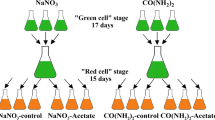Abstract
Among the highly valued ketocarotenoids employed for food coloration, astaxanthin is probably the most important. This carotenoid may be produced biotechnologically by a number of microorganisms, and the most promising seems to be the freshwater flagellate Haematococcus pluvialis (Chlorophyceae), which accumulate astaxanthin in their aplanospores. Many physiological aspects of the transition of the flagellate into aplanospores have been described. Mixotrophic cultivation and suitable irradiance may result in fairly good yields (up to 40 mg/l; 43 mg/g cell dry weight) within a reasonable time, under laboratory conditions. In order to compete with synthetic astaxanthin, suitable scaling-up is required. However, large-scale production in open ponds has proved unsatisfactory because of severe contamination problems. A selective medium might overcome this difficulty. Further research for the development of suitable strains is thus warranted.
Similar content being viewed by others
Author information
Authors and Affiliations
Additional information
Received: 8 July 1998 / Received revision: 12 November 1998 / Accepted: 14 November 1998
Rights and permissions
About this article
Cite this article
Margalith, P. Production of ketocarotenoids by microalgae. Appl Microbiol Biotechnol 51, 431–438 (1999). https://doi.org/10.1007/s002530051413
Issue Date:
DOI: https://doi.org/10.1007/s002530051413




